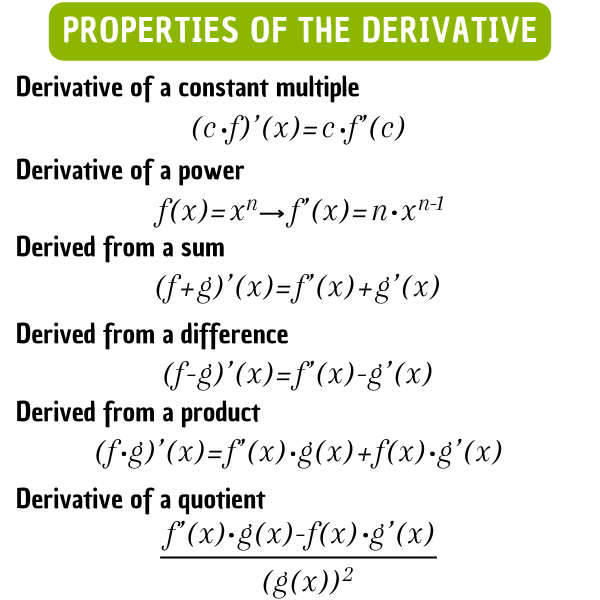Properties of the derivative solved exercises
Basic properties of the derivative
The basic properties of the derivative to find the derivative of a function are:
Derivative of a constant function
If \(f\) is a constant function, that is, \(f(x)=k\), then:
This property states that the derivative of a constant function is equal to zero.
Derivative of a constant multiple
If \(f\) is a function differentiable on \(x\), and \(c\) is a constant, then:
This property states that the derivative of the product of a constant and a function is equal to the constant multiplied by the derivative of the function.
Derivative of a power
If \(f\) is a function defined by \(f(x)=x^n\), where \(n\) is any real number other than zero, then:
This property states that the derivative of \(x\) raised to any exponent is equal to the exponent multiplied by \(x\) raised to the same exponent minus one.
Recommended article: Properties of powers solved exercises
Derivative of a sum of functions
If \(f\) and \(g\) are differentiable functions on \(x\), then:
This property states that the derivative of a sum of functions is equal to the sum of the derivatives of each of the functions separately.
Derived from a difference of functions
If \(f\) and \(g\) are differentiable functions on \(x\), then:
This property states that the derivative of a difference of functions is equal to the difference of the derivatives of each of the functions separately.
Derived from a product of functions
If \(f\) and \(g\) are differentiable functions on \(x\), then:
This property states that the derivative of the product of two functions is equal to the sum of the product of the derivative of the first function by the second, plus the product of the first function by the derivative of the second function. In other words, the derivative of the product of two functions is equal to the derivative of the first function multiplied by the second function unchanged, plus the first function multiplied by the derivative of the second function.
Derivative of a quotient of functions
If \(f\) and \(g\) are differentiable functions on \(x\), then:
This property states that the derivative of a division of two functions is equal to the derivative of the numerator function multiplied by the denominator function, minus the numerator function multiplied by the derivative of the denominator function, all divided by the square of the denominator function.

Derivatives solved exercises
Learn more about the derivative and its properties in: Derivative of A Function- Calculus
Recommended article: Properties of logarithms solved exercises